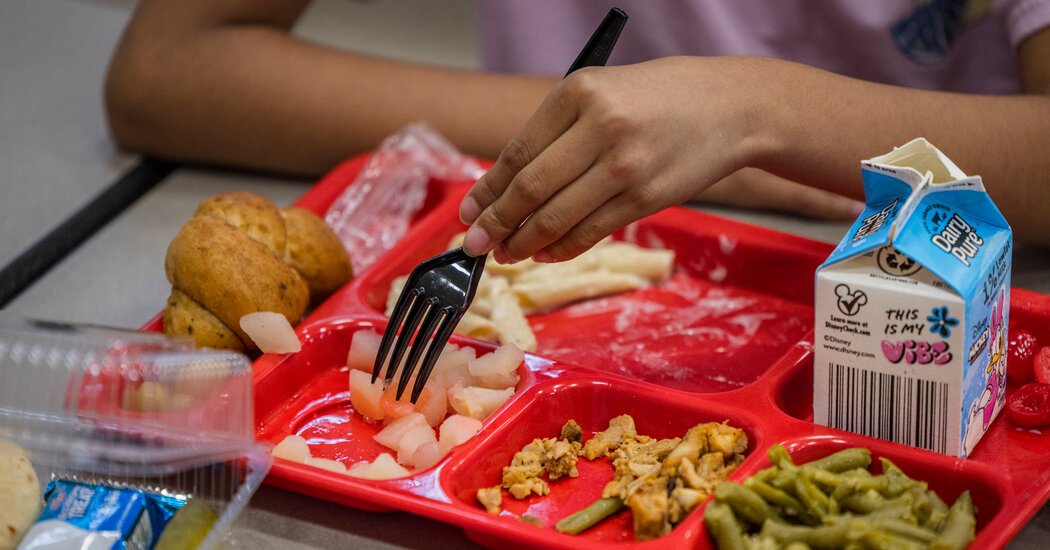Under new nutritional guidelines released by the Biden administration, school lunches will soon have less salt and sugar, but they can still include chocolate milk.
The Department of Agriculture announced Wednesday that after feedback from food companies and school nutrition experts and more than 136,000 public comments, it has weakened some provisions and finalized the originally proposed regulations in February 2023. did.
“All of this is aimed at ensuring that students receive high-quality meals and that parents’ expectations that their children receive healthy, nutritious meals at school are met,” the Secretary of Agriculture said. Tom Vilsack said on a call with reporters Tuesday.
The new guidelines aim to better align school meals with federal dietary standards and build on a 2010 law aimed at making cafeteria breakfasts and lunches healthier. The law was championed by Michelle Obama when she was first lady, but it quickly became embroiled in political controversy. The Trump administration repeatedly attempted to lower nutrition standards, but the Biden administration eased certain provisions to allow for more flexibility during the coronavirus pandemic.
In fiscal year 2023, approximately 28.6 million students received or purchased lunch through the National School Lunch Program, and the school lunch and breakfast program cost the federal government approximately $21 billion.
When the USDA proposed updating the standards last year, school nutrition experts argued that enforcing the guidelines was unrealistic, and dairy organizations expressed concern about what they called a push to restrict milk. The final rule reflects some of these concerns.
Under the rules, which go into effect on July 1, schools will have to limit the amount of added sugar in cereals and yogurts they serve starting in the 2025-26 school year, with gradual increases in reductions in other foods. .
Added sugar now accounts for around 17 per cent of the calories in school breakfasts and 11 per cent of the calories in school lunches, on average, according to a May 2022 government report. Federal dietary guidelines recommend that a person get no more than 10 percent of their daily calories from added sugars.
Jamie B. Bussell of the Robert Wood Johnson Foundation, a nonprofit health organization, said the new restrictions are “an important step toward reducing children’s risk of chronic diseases such as type 2 diabetes and heart disease. ”.
Industry group the Sugar Association said it supported limiting added sugar on weekly menus, but argued it was “arbitrary” to apply limits to individual products such as flavored dairy products. . The group also warned that the new standards could lead to increased use of artificial sweeteners, which are not being addressed but could have negative health effects.
Schools must reduce sodium in lunches by 15 percent from current levels and sodium in breakfast by 10 percent by the 2027-28 school year. This is down from a proposed 30% reduction by the 2029-30 school year. Mr. Vilsack said the USDA was unable to implement more meaningful sodium reduction efforts because it was effectively handcuffed by a policy rider in the spending package that Congress approved in March that limited sodium reduction in school meals. said.
Current standards limit sodium intake for students in kindergarten through fifth grade to 1,650 milligrams for breakfast and lunch combined, and the rider effectively caps that level at 1,420 milligrams. Federal dietary guidelines recommend that children between the ages of 4 and 8 have a daily sodium intake of no more than 1,500 milligrams.
Dairy products were also spared further cuts. Under the final rule, students can continue drinking chocolate, strawberry and other flavored milks as long as they meet the added sugar limit.
Flavored milk was the main source of added sugar in school meals, according to a 2022 government report. The Department of Agriculture was considering banning K-5 grade beverages under the proposed regulations. But Vilsack said he has stopped doing so because the dairy industry is “taking up the challenge” and working to produce flavored dairy products with less sugar.
The final rule also maintains the current standard requiring that 80% of grains and legumes served be whole grains. The agency was considering requiring all grains to be whole, with a once-a-week exception for refined grain products.
The School Nutrition Association, which represents cafeteria workers and executives across the country, expressed gratitude that the finalized regulations reflect that feedback. However, the announcement was met with mixed reactions from the food industry and health advocacy groups.
The International Dairy Association praised the decision to preserve flavored milk, but said the USDA was a “missed opportunity” to reinstate whole milk and 2% milk in school lunches.
Nancy Brown, CEO of the American Heart Association, said her organization is satisfied with the added sugar cap, but that the rules require 100 percent whole grains and greater sodium reduction. He said he was disappointed that it had not.

